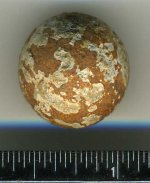Erik in NJ
Silver Member
- Oct 4, 2010
- 4,037
- 3,043
- 🥇 Banner finds
- 1
- Detector(s) used
- Minelab Explorer SE Pro & CTX-3030
- Primary Interest:
- Metal Detecting
This lead ball was found on the former British Isle not far from where I found the beautiful 1600's Openwork Bridal Boss. It is round and measures approx 5/8" in diameter. It was found in a somewhat wet area. Thanks fo any help!





 I can tell you this here where I hunt you will find far more small size musket (I call shot) that comes from colonial sites then the larger ones.Just a fact.I find them almost every hunt.Even have found the strips that they go to.Small shot was very common in the 1600's & early 1700's.As you can see in my post.
I can tell you this here where I hunt you will find far more small size musket (I call shot) that comes from colonial sites then the larger ones.Just a fact.I find them almost every hunt.Even have found the strips that they go to.Small shot was very common in the 1600's & early 1700's.As you can see in my post.
 But he clearly states that it was found on a former British Isle.So why is military(REV.WAR-Civil War) involved
But he clearly states that it was found on a former British Isle.So why is military(REV.WAR-Civil War) involved I know his Bridel boss was 1600's.All I know is they used small,large almost anything they could pack down a barrel back then.
I know his Bridel boss was 1600's.All I know is they used small,large almost anything they could pack down a barrel back then.



